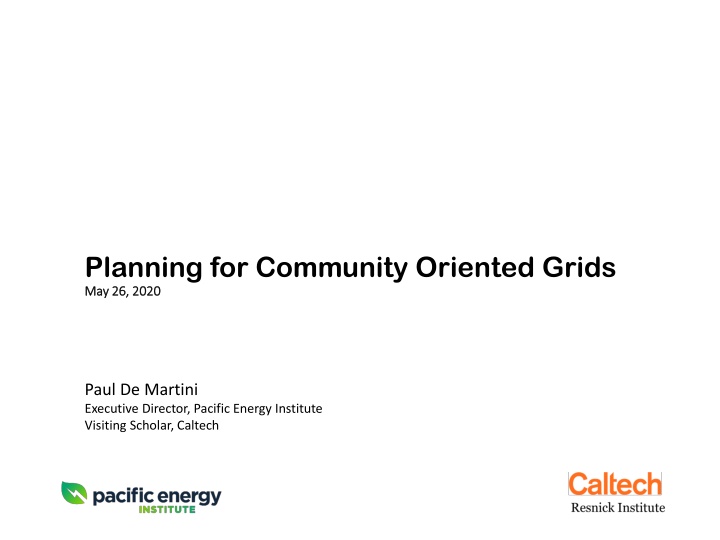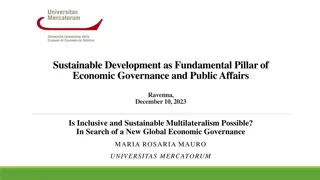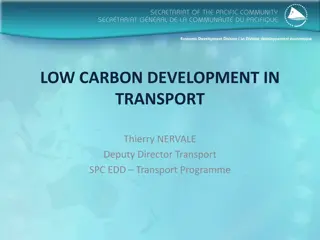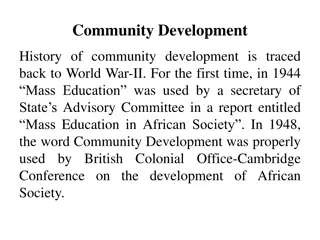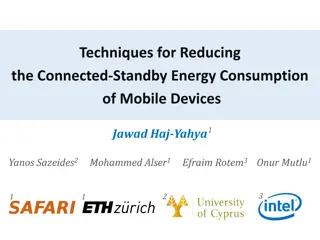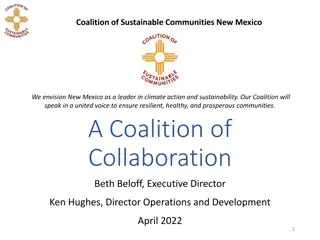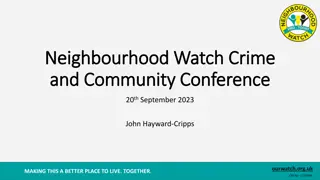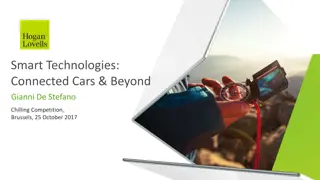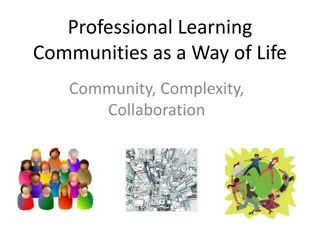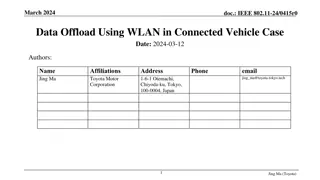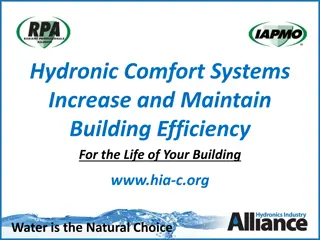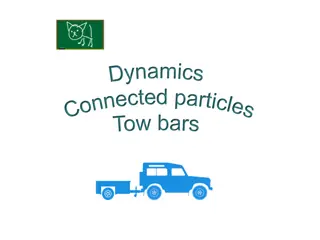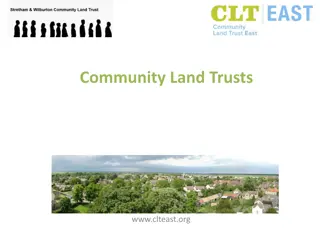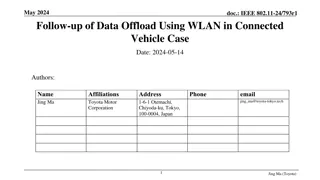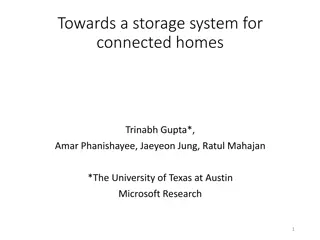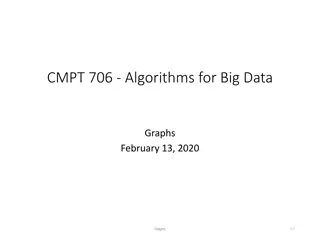Building Sustainable & Connected Communities
Building Sustainable & Connected Communities is crucial for improving societal value through efficient use of clean, resilient electricity. Transit Oriented Development (TOD) concepts play a key role in enhancing Quality of Life, Economic Competitiveness, Resilience, and addressing Climate Change. By incorporating elements like Transportation Electrification, Critical Infrastructure Resiliency, and Local Distributed Resource Development, communities can create a more sustainable future.
Download Presentation

Please find below an Image/Link to download the presentation.
The content on the website is provided AS IS for your information and personal use only. It may not be sold, licensed, or shared on other websites without obtaining consent from the author.If you encounter any issues during the download, it is possible that the publisher has removed the file from their server.
You are allowed to download the files provided on this website for personal or commercial use, subject to the condition that they are used lawfully. All files are the property of their respective owners.
The content on the website is provided AS IS for your information and personal use only. It may not be sold, licensed, or shared on other websites without obtaining consent from the author.
E N D
Presentation Transcript
Planning for Community Oriented Grids May 26, 2020 May 26, 2020 Paul De Martini Executive Director, Pacific Energy Institute Visiting Scholar, Caltech
The future has arrived it s just not evenly distributed yet. William Gibson 2
Cities are Taking Action Cities are Taking Action 3
Transit Oriented Development (TOD) concepts are relevant Transit Oriented Development (TOD) concepts are relevant to electric planning to electric planning 4 TOD is a design approach employed in connected communities that are improving societal value by: Improving Quality of Life Economic Competitiveness Improving Resilience Addressing Climate change American Fork, Utah These community development efforts typically incorporate energy related elements including: Transportation Electrification Critical Infrastructure Resiliency Local Distributed Resource Development Source: PSOMAS 4
Sustainable & Connected Communities Sustainable & Connected Communities Building & Transportation Electrification + DER + Grid Platform Enable Connected Communities Societal value from the creation of Sustainable & Connected Communities accrues in significant part based on the efficient use of clean, resilient electricity Connected communities in many metro areas will be supplied increasingly in large part by distributed resources (perhaps 35% or more by 2040) Connected communities will need to be resilient this will depend in part on microgrids and other customer resources that need to be linked Connected communities are dependent upon a node-friendly distribution network that is open, visible, flexible, reliable, resilient and safe* *More Than Smart principle adopted by CPUC 5
Community Critical Infrastructure Interdependencies Community Critical Infrastructure Interdependencies Electrification and distributed resources necessitate closer examination of the interdependencies among critical infrastructure and the distribution grid. Context: Distribution grids in the United States are on average ~30-years old (of ~40-year asset life), with increasing demands from electrification, large scale adoption of unregulated distributed generation & storage, or use of distributed resources to provide critical grid operational functions. That places significant challenges on a system that was not structured & designed for this new reality. 6
Planning for a Grid 2035 Planning for a Grid 2035 Need to take a more holistic view of needs from a local societal perspective What are counties & cities pursuing? State regulation and electric system planning tend to lag local climate and sustainable action plans This lag will become a major issue later this decade as local actions will overtake traditional electric system planning focus and cycles Understand the desired end state (e.g., Portland 2035) 1. How is clean electricity used, produced, transported and to whom 2. What are the market overlays that may be needed to enable efficient pricing and use of resources 3. What is the role of the electric grid in 2035 4. What are the resilience considerations for such a Y2035 electric ecosystem Back-cast to today s starting point and identify the key signposts and associated milestones to evolve toward 2035 Caution to avoid incrementalism in energy policy and solutions that don t scale leading to cul-de-sacs and political/customer friction Examples of this dynamic have already occurred in Hawaii, Puerto Rico, California 7
Long Long- -term Distribution Planning term Distribution Planning Planning for Grid 2035 requires a more holistic view of needed inputs and criteria much more explicit inclusion of local policies and action plans Planning Inputs Planning Analysis Resilience & Reliability Expansion & Modernization Asset Planning Source: P. De Martini 8
Evolution of Customer/Community & Distribution Evolution of Customer/Community & Distribution What is the scope, scale and pace of change toward a more distributed system? 9
Electric Transactions 2035? Electric Transactions 2035? Already beginning to see this transformation in US electric systems Wholesale Markets Independent Generation Power Traders Transmission Owners RTOs Distributed Transactions Distribution Utility Energy Sales Competitive Energy Sales DER Devices Sales DER/Microgrid Services Aggregators 10
Transportation Network Characteristics Transportation Network Characteristics Adapting Transportation Concepts for Sustainable & Connected Communities Connectivity: Connectivity refers to the density of connections in path or road networks, capacity and directness of links. Accessibility: Accessibility refers to market access measured through statistical indicators of effective market size or effective market density and ease of access. Availability: Availability refers to a transportation system's performance to deliver services when demanded. 11
Distribution Network Criteria Distribution Network Criteria California s highly distributed electric system will need to address these criteria 12
Transactive Distribution Grid Design Concept Transactive Distribution Grid Design Concept Distribution transactions Create transaction hub at low-side of T-D Substation transformer bank, associated distribution bus section and feeders Distribution transactions are scheduled for delivery to and from this hub via corresponding injection and take-out points on interconnected circuits Injection Point Physical location at which scheduled power is injected into distribution system Take Out Point Physical location of the recipient of energy from the scheduled power. Distribution to transmission transactions Interchange scheduling point is the associated LMP node on high side of substation transformer bank. 13 13
Distribution Grid as a Network Platform Distribution Grid as a Network Platform Electric Distribution Network Value Can Be Super Linear Metcalfe s Law: Value of a network grows at the square of the number of connections not applicable to electric grids Geoffrey West: With each increase in size, cities get a super-linear value-add of 15% in increased efficiency and productivity. De Martini-ICF: Increases in DER, electrified buildings and EVs (number of grid connections) create super-linear societal value - findings consistent with West s Scale research Distribution Network Value Accumulated Network Value Societal Value Traditional Linear Value based on Electric Sales Connections 14
Distribution Network Value Potential Distribution Network Value Potential Realizing the value potential requires a different mental model The cyber-physical grid infrastructure can provide the foundation for network value creation Total value increases through the interdependent capabilities of each value layer Higher electrification and DER adoption drives value Capturing benefits requires a broader view of the solution set and deliberate alternative grid designs & investment to support value realization 15
Distribution System Planning Distribution System Planning Multiple community & utility distribution planning efforts often involved need to converge to ensure optimal grid investments & non-utility solutions County & City Planning Grid Modernization Resilience & Reliability Asset Planning 16
Determining Portfolio of Resilience Solutions Determining Portfolio of Resilience Solutions Proactive, collaborative approach required to align state, local and customer needs Challenge communities, utilities, 3rd parties and customers are each independently pursuing various point & community solutions Community: Cyber-Physical Grid Hardening, Mini- grids, Multi-user Microgrids, etc. Point Solutions: Back-up generation, energy storage, customer microgrid, etc. Specific solutions don t necessarily solve all the needs a portfolio is needed Solutions usually address specific functional resilience needs Solutions have different potential societal benefits based on type of event and severity How to determine an effective portfolio? 17
A Future History of the Grid A Future History of the Grid Many possible futures essential to consider the potential implications Grid as a Platform Transactive Energy Resilience DER Integration DER Centric Integrated Distributed Planning NWA Utilization Smart Grid Interconnection Rules Retail Energy Market: Post-NEM - Buy- Sell Contracts with Customers w/DER Subscription pricing for customers System Operations: Energy storage greatly dampens stochasticity Zero marginal cost resources reduce LMP effectiveness Local utilization of DER changes wholesale market Community: Environmental & Nation State Threats Critical facilities and essential services Neighborhood Grid Structural Design Changes Customer: Point Solutions Multi-user MGs Enabling Grid Electrification ZNE Adoption DER for Resource Adequacy Grid Modernization TDC Operational Coordination 2010-2030 2015-2035 2030-2040 18
Considerations for Grid 2035 Considerations for Grid 2035 Future architecture of community dominant transactive distributed power systems will be influenced by connected, resilient community development employing transit-oriented development (TOD) designs. Technological advancement is accelerating and there will be new and larger societal impacts from emergent technologies over the next decade as seen over the past 10+ years Large scale use of DER for resource adequacy will fundamentally change the design requirements for distribution grid A community oriented grid (COG) architecture would inform electricity market designs, grid investments, operational coordination (including interoperability) and public policy shaping DER adoption. Role and value of electric grid to enable clean, electrified & resilient communities is not fully understood by all stakeholders Shift from scarcity thinking to abundance thinking regarding the significant value potential created from grid investment? 19
The future belongs to those who prepare for it today. Malcolm X https://pacificenergyinstitute.org/ 20
